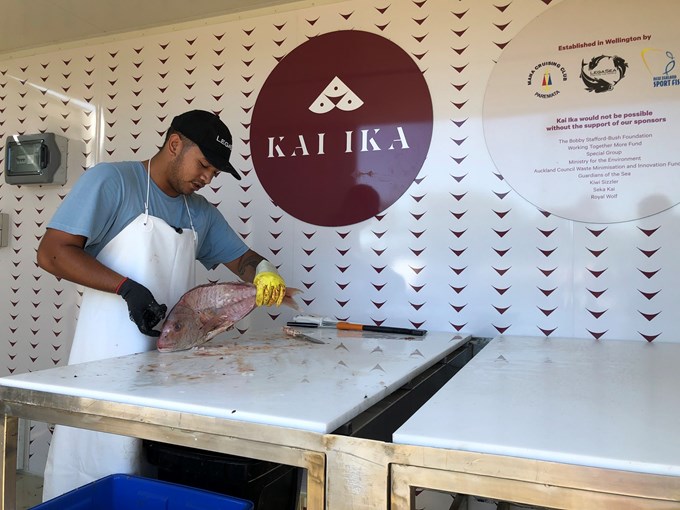In te reo Māori, the head of the fish is called rangatira kai, meaning chief’s food. In many cultures, fish heads are considered a delicacy. Fish head soups and curries are a staple of diets around the world.
If you’ve never eaten a fish head, you are excused for not knowing that they have sizzling fat and extra-tender meat along the jaw, in the cheeks and below the gill plates - “the wings". The parts of fish that are often discarded as waste are actually high in vitamin A, omega-3 fatty acids, iron, zinc and calcium.
How the Kai Ika project works
The Kai Ika project is a collaboration between LegaSea, Outboard Boating Club and Papatūānuku Kōkiri Marae.
Together, they collect the parts of fish that are being discarded and turn them into healthy kai for local communities. They received funding from Auckland Council to help scale up their ambitious project and meet the high demand for fish meat from the 65 per cent of a fish that was otherwise going to waste.
Boaties can drop off their fish parts, and the Kai Ika team will get them to a good home. Together, they have shared more than 52,000 kg of fish with the local community.
The Outboard Boating Club of Auckland has installed fridges and freezers in their fish filleting facilities so the members’ unwanted fish parts can be kept fresh for the Kai Ika team to collect. When given to an appreciative local community, what was previously seen as fish waste is transformed into a delicacy.
The programme means fish parts are no longer being dumped overboard or otherwise discarded into our waste streams.
For a small koha, the fish can even be filleted for you on-site. The project is currently looking to expand and offer the same services at Westhaven Marina.
Watch a fish being filleted:
Papatūānuku Kōkiri Marae plays a crucial role in converting waste from one part of the community into nourishment for others. Volunteers from the marae in Māngere distribute the kai moana to hundreds of families and community groups that are eager to receive them. The marae is about to begin teaching at-risk youth how to cook. Critical life skills like these are mana enhancing and empowering for these kids as it helps them develop within their families.
Community committee chair, Councillor Alf Filipaina recognises the benefits this programme is having for the local neighbourhood. “The simple concept of sharing food with those who want it is the backbone of a healthy community. Every meal someone makes from this project can also mean that less kai moana is coming out of the sea. People are getting to know each other and bridging cultural divides while making sure valuable food is not wasted.”
The possibilities are endless
The demand for fish parts, and the desire to get rid of them, is seemingly endless. Fish 'n' chips shops and grocery store chains are eager to have this model applied commercially. The desire to eat the fish heads, wings, and frames far outpaces the current supply.
This year, the project is working to open the Kai Moana Innovation Hub to experiment with new recipes for the fish parts. The shipping container company Royal Wolf is outfitting a filleting station with fridges, freezers, smokers, dehydrators, and other equipment to allow further innovation. It’s a model the project hopes to replicate at maraes around the country.
Every part of the fish is used, even the inedible parts. Papatūānuku Kōkiri Marae set up extensive community gardens nearly 30 years ago on two hectares of land. Any fish parts unsuitable for food are used as fertiliser to grow up to 80,000 kumara a year.
Climate change and environment committee chair Councillor Richard Hills is inspired by the manaakitanga of the Kai Ika project.
“The humility and generosity of the volunteers involved is a testament to what our community is capable of. This is a fantastic way to take care of our environment while taking care of each other. Tino pai to mahi!”
Sam from LegaSea is grateful for the boost from Auckland Council and all the project partners. “Seeing that someone was willing to invest in us reassured us that the impact on the zero waste goals is massive. It motivates us to want to do more.”
Recipe for fish heads
Want to give fish head cooking a try, but don’t know where to start? The Kai Ika project recommends this simple soup recipe"
Boil the heads and frames for a couple minutes. Then strip off the flesh and set it aside.
Continue to boil the bones for a further 20 minutes. Then pound with your potato masher and strain the liquid from the bones.
In another pot, heat equal parts of butter and flour, then add the stock to make a roux. Once it has softened, add parsley and just before serving reintroduce the fish meat you put aside.
You can have this fish soup as is or dress it up with coconut milk, vegetables or noodles.


